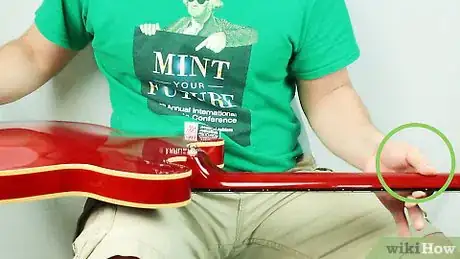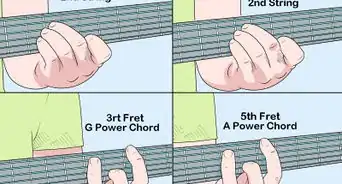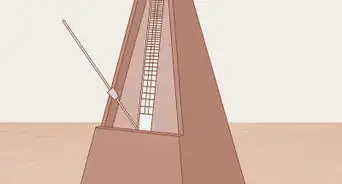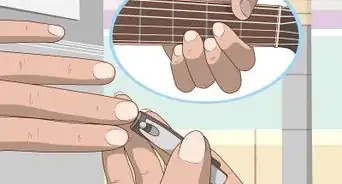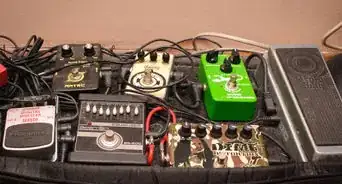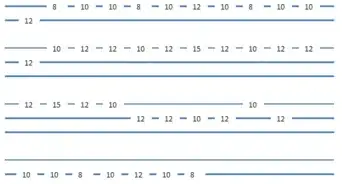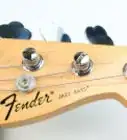This article was co-authored by Michael Papenburg. Michael Papenburg is a Professional Guitarist based in the San Francisco Bay Area with over 35 years of teaching and performing experience. He specializes in rock, alternative, slide guitar, blues, funk, country, and folk. Michael has played with Bay Area local artists including Matadore, The Jerry Hannan Band, Matt Nathanson, Brittany Shane, and Orange. Michael currently plays lead guitar for Petty Theft, a tribute to Tom Petty and the Heartbreakers.
This article has been viewed 173,304 times.
Sooner or later every guitarist reaches the point where they want to play longer and faster. Regular practice of basic techniques will not only speed up your playing and make learning new techniques easier, it will also strengthen your fingers so that you can play a full night's gig without your hand cramping up. The best way to increase speed and finger strength is to practice-- but you have to practice efficiently.
Steps
Improving your Technique
-
1Use your thumb to push on the back of the fretboard, clamping your fingers together powerfully. Think about pushing your index finger and thumb together, like you were snapping. Now just put the neck of the guitar between your fingers. You want to be able to squeeze your fingers up against your thumb for the best power, allowing your whole hand -- not just your fretting fingers-- to provide strength.[1]
-
2Keep your wrist relaxed, with the back of your hand facing the floor. You don't want to angle it forward because this makes it impossible to push hard on the frets. You don't want to angle it towards your body because this makes it hard to quickly reach the top of the fretboard.[2]Advertisement
-
3Place your finger right behind the fret when playing. The further away from the fret you are, the harder you have to work in order to hold the string down. You'll be much faster and more efficient if you place your hands right behind the fret. By behind, this means towards the head of the guitar. So, if you're right handed, you want to be just to the left of the fret you're playing.
-
4Find your personal perfect "height" for barre chords, holding all six strings at once with one finger. Your vertical finger placement, or how high you place the tip of your finger when barring chords, will change from person to person. One of the best ways to increase finger strength is to figure out how you can hold all six strings at once and get a clear, consistent sound. Practice quickly barring notes, removing and placing your hand as fast as you can while playing all notes clearly.
- The joints in your fingers might make it hard to play some strings. But this is why you need to adjust how high your index finger goes -- don't just assume that you must have the tip of your finger on the top string.
- Experiment with putting the bar on first, then the shape of the chord, and vice versa. Neither strategy is right -- just find out which method works fastest for you.
-
5Tilt your fingers slightly to use the bony area on the side of your finger. You're just going to rotate your finger slightly to make it work. If you're right-handed you'll tilt your hands just slightly to the left, towards the head of the guitar. The harder surface will require less power to hold the string down, making it much easier to get perfect chords and notes quickly.
-
6Drop your elbow down, keeping it in towards your body. This takes the weight off of your arm, bringing the weight of the guitar towards the center of your body. With less weight to support, you can easily get more power and speed through your arm. You want to tilt from the wrist, not your elbow. Keep your elbow in, towards you body, instead of flaring it out to the side.
-
7Picking it up after every fret, barre all six strings and move up and down the neck. Move your barre up every single fret, picking it up and placing it down. Once you can do this easily, try it with a full barre chord, moving it up and down the neck. This builds the forearm and finger strength needed to play quickly.
- If you're struggling at first, try to use a second finger to help hold down your barre. As you gain strength you can take it off.
-
8Alternate between two chords, slowly picking up speed, to work on quick chord transitions and power. Once you get barre chords, move on to open chords. Play a G, remove your hand, then play a C. Alternate back and forth, adding new chords in time with the metronome. Then alternate between barre chords and open chords to take your playing to the next level.
-
9Get your guitar serviced to fit your strength and play style. While most of your speed comes from practice, there are things you can do to your guitar to make it smoother and easier to play. Getting a guitar serviced by a professional will make practicing more enjoyable, as it makes the strings easier to play. You should consider:
- Lower-Guage Strings: This means the strings are thinner, meaning they take less power to hold down and can thus be played faster. Your sound will get slightly tinnier and softer.
- Lowering the Action: The action is the distance between the strings and the fretboard. There is little reason for a lot action -- this usually means the guitar is long overdue for servicing.
Strength and Speed Exercises
-
1Practice with a metronome to ensure you're actually improving your speed. You might "feel" faster, but you'll never actually know unless you have a metronome to help keep track of time.[3] Keep track of your times and speeds, starting around 60 BPM and moving up when you're comfortable. After running through the exercise a couple times at the previous session's speed, push the tempo faster by ten beats per minute and continue practicing each example until you feel comfortable with the new speed.
- Always play at a speed where you can hit every note cleanly, not just hit every note. It doesn't help to play quickly if half the notes are missing.
-
2Alternate your picking, moving up and down across strings. Using down strokes, up strokes, and alternating strokes, practice this at a tempo that you are able to manage, but fast enough that you cannot do it for long before your fingers tire. Try to do the following exercise, up and down the fretboard, once with up-strokes, once with down strokes, and once with alternating picking:
e----------------------------------------5--7--------------
B---------------------------------5--7--------------------
G--------------------------5--7---------------------------
D-------------------5--7----------------------------------
A------------5--7-----------------------------------------
E----5---7------------------------------------------------ -
3Use hammer-ons and pull-offs to play more complicated licks with speed. Hammer-ons and pulls-offs are ways to sound notes without actually strumming them. This means you can strum a different note, or just squeeze in an extra note between picking.[4] Both techniques use your fretting hand to sound out notes right on the
- Hammer-Ons are when you quickly slam your finger down on a string, right near the fret. You should hit it hard enough that it sounds out. It will be a bit quieter than a normally picked note.
- Pull-Offs require two fingers on the same string -- try your index on the 5th fret and your ring finger on the 7th. Keeping your finger on the 5th fret, pick up your ring finger, "picking" the string with your ring finger at the 7th fret.
- Using Both: Pick a note normally, using your index finger on the 5th fret. Then hammer down on the 7th fret to make it sound out. As you finish, pull-off the 7th fret -- you've only picked one string, but you've sounded out three notes!
-
4Aim for a speed where you can play notes perfectly, not quickly with mistakes. As always, try to play with an accurate tempo and clean articulation. You want each note to be clean, clear, and precise. The fastest playing in the world sounds terrible if every other note is missed or off.[5]
-
5Run through the following pattern using all of your fingers to work on single-note speed. Take the following exercise only as quickly as you do it without mistakes. Make sure you use a metronome to keep yourself on time. As soon as you get to the end, turn back and do the whole thing backward again -- you need to get speed and strength moving both directions. As you get better, work on new picking patterns, add hammer-ons, and make the metronome faster.
e|--------------------------------------------------------------5-6-7-8-----
B|---------------------------------------------------5-6-7-8---------------
G|---------------------------------------5-6-7-8---------------------------
D|----------------------------5-6-7-8--------------------------------------
A|-----------------5-6-7-8-------------------------------------------------
E|-----5-6-7-8-------------------------------------------------------------
Expert Q&A
Did you know you can get expert answers for this article?
Unlock expert answers by supporting wikiHow
-
QuestionHow can I make my fingers stronger?
 Michael PapenburgMichael Papenburg is a Professional Guitarist based in the San Francisco Bay Area with over 35 years of teaching and performing experience. He specializes in rock, alternative, slide guitar, blues, funk, country, and folk. Michael has played with Bay Area local artists including Matadore, The Jerry Hannan Band, Matt Nathanson, Brittany Shane, and Orange. Michael currently plays lead guitar for Petty Theft, a tribute to Tom Petty and the Heartbreakers.
Michael PapenburgMichael Papenburg is a Professional Guitarist based in the San Francisco Bay Area with over 35 years of teaching and performing experience. He specializes in rock, alternative, slide guitar, blues, funk, country, and folk. Michael has played with Bay Area local artists including Matadore, The Jerry Hannan Band, Matt Nathanson, Brittany Shane, and Orange. Michael currently plays lead guitar for Petty Theft, a tribute to Tom Petty and the Heartbreakers.
Professional Guitarist The best way to strengthen your fingers is to practice. There are exercises that you can do to help you improve your finger strength, but to me, I'd rather just spend another hour practicing. Whenever you play the guitar, you're developing the muscle memory and dexterity that you need. If you practice enough, it's amazing how strong your hands can become.
The best way to strengthen your fingers is to practice. There are exercises that you can do to help you improve your finger strength, but to me, I'd rather just spend another hour practicing. Whenever you play the guitar, you're developing the muscle memory and dexterity that you need. If you practice enough, it's amazing how strong your hands can become. -
QuestionHow do you increase hand speed on a fret?
 Michael PapenburgMichael Papenburg is a Professional Guitarist based in the San Francisco Bay Area with over 35 years of teaching and performing experience. He specializes in rock, alternative, slide guitar, blues, funk, country, and folk. Michael has played with Bay Area local artists including Matadore, The Jerry Hannan Band, Matt Nathanson, Brittany Shane, and Orange. Michael currently plays lead guitar for Petty Theft, a tribute to Tom Petty and the Heartbreakers.
Michael PapenburgMichael Papenburg is a Professional Guitarist based in the San Francisco Bay Area with over 35 years of teaching and performing experience. He specializes in rock, alternative, slide guitar, blues, funk, country, and folk. Michael has played with Bay Area local artists including Matadore, The Jerry Hannan Band, Matt Nathanson, Brittany Shane, and Orange. Michael currently plays lead guitar for Petty Theft, a tribute to Tom Petty and the Heartbreakers.
Professional Guitarist Try this exercise: Pick 4 frets in a row on the guitar, then start on the low E string and alternate pick, down, up, down, up, along with the metronome. As you finish that, move to the next string, and the next one, until you get to the top. Once you finish the top string, go up a fret, then go down the strings again. That will help you sync your left and right hand so you're moving your finger and picking at the exact same moment. Then, gradually increase your speed.
Try this exercise: Pick 4 frets in a row on the guitar, then start on the low E string and alternate pick, down, up, down, up, along with the metronome. As you finish that, move to the next string, and the next one, until you get to the top. Once you finish the top string, go up a fret, then go down the strings again. That will help you sync your left and right hand so you're moving your finger and picking at the exact same moment. Then, gradually increase your speed. -
QuestionHow can I improve my guitar speed and accuracy?
 Michael PapenburgMichael Papenburg is a Professional Guitarist based in the San Francisco Bay Area with over 35 years of teaching and performing experience. He specializes in rock, alternative, slide guitar, blues, funk, country, and folk. Michael has played with Bay Area local artists including Matadore, The Jerry Hannan Band, Matt Nathanson, Brittany Shane, and Orange. Michael currently plays lead guitar for Petty Theft, a tribute to Tom Petty and the Heartbreakers.
Michael PapenburgMichael Papenburg is a Professional Guitarist based in the San Francisco Bay Area with over 35 years of teaching and performing experience. He specializes in rock, alternative, slide guitar, blues, funk, country, and folk. Michael has played with Bay Area local artists including Matadore, The Jerry Hannan Band, Matt Nathanson, Brittany Shane, and Orange. Michael currently plays lead guitar for Petty Theft, a tribute to Tom Petty and the Heartbreakers.
Professional Guitarist Start slow and work up to a faster speed. If you're trying to play a fast, complicated line, it can be really hard to jump right into the fast speed. You might find yourself stumbling over the notes, and you might not be quite up to the muscle memory required for the part. Start by playing it at a speed you're comfortable with, then slowly increase that speed. Focus on consistency. Try practicing along with a metronome to ensure you're keeping time accurately.
Start slow and work up to a faster speed. If you're trying to play a fast, complicated line, it can be really hard to jump right into the fast speed. You might find yourself stumbling over the notes, and you might not be quite up to the muscle memory required for the part. Start by playing it at a speed you're comfortable with, then slowly increase that speed. Focus on consistency. Try practicing along with a metronome to ensure you're keeping time accurately.
References
- ↑ https://www.studybass.com/lessons/bass-technique/fretting/
- ↑ https://www.libertyparkmusic.com/5-must-know-fretting-techniques-for-beginner-guitarists/
- ↑ https://www.guitarworld.com/lessons/tips-guitarists-how-build-shredding-speed
- ↑ https://www.fender.com/articles/how-to/master-hammer-ons-and-pull-offs
- ↑ https://www.libertyparkmusic.com/the-guitar-jedi-workout/
- Videos from GuitarLessons.com
